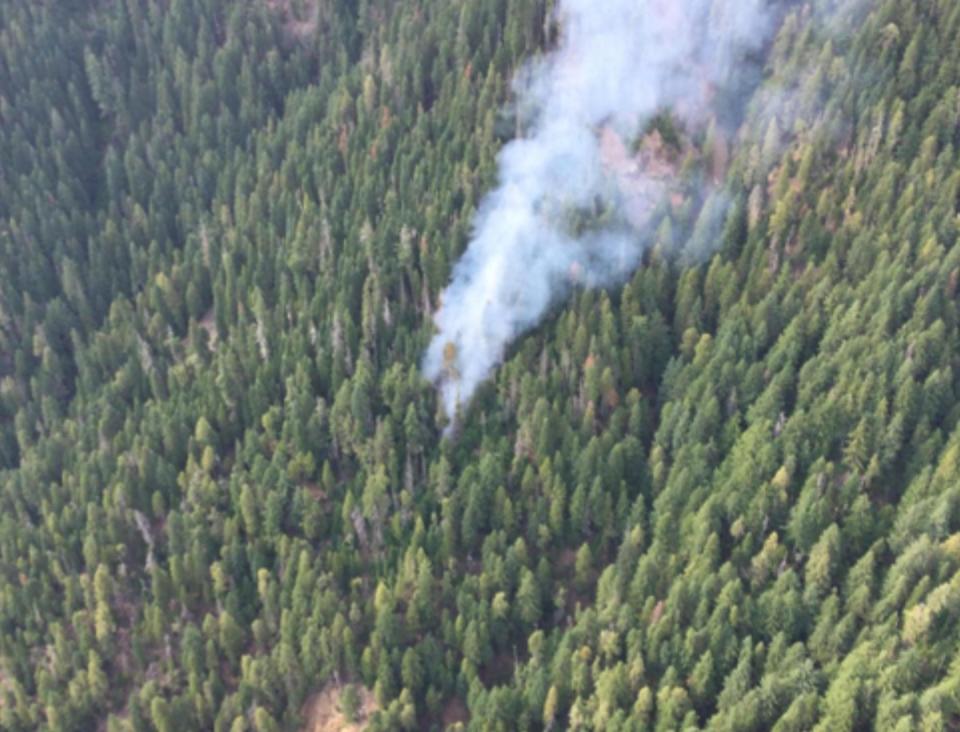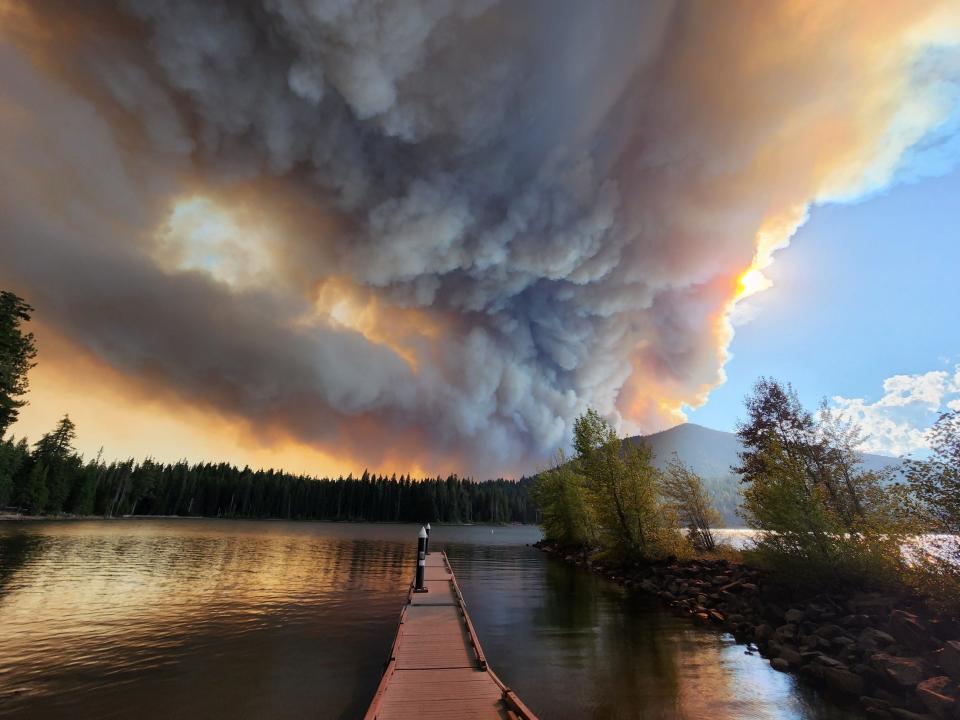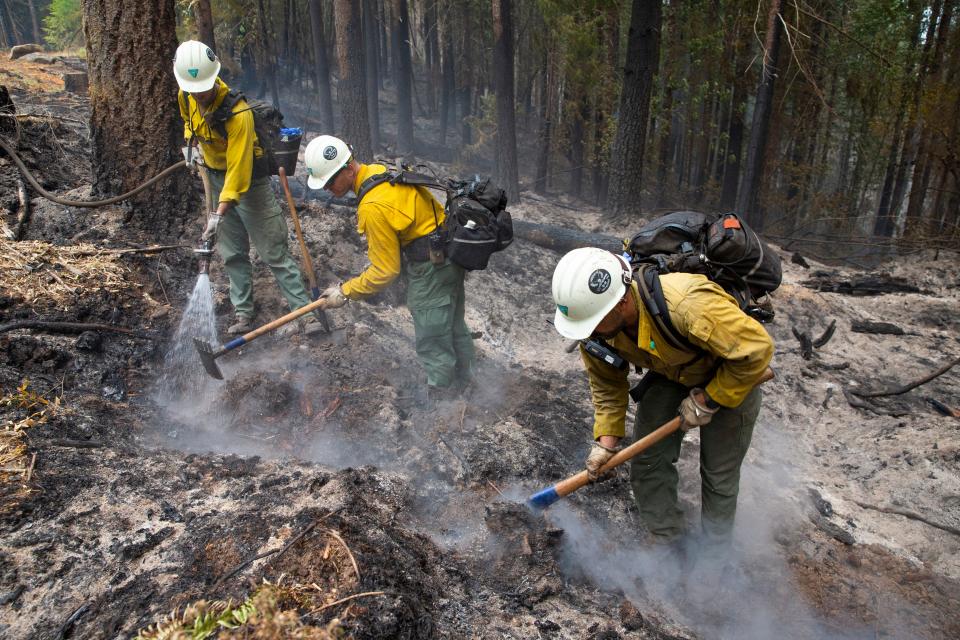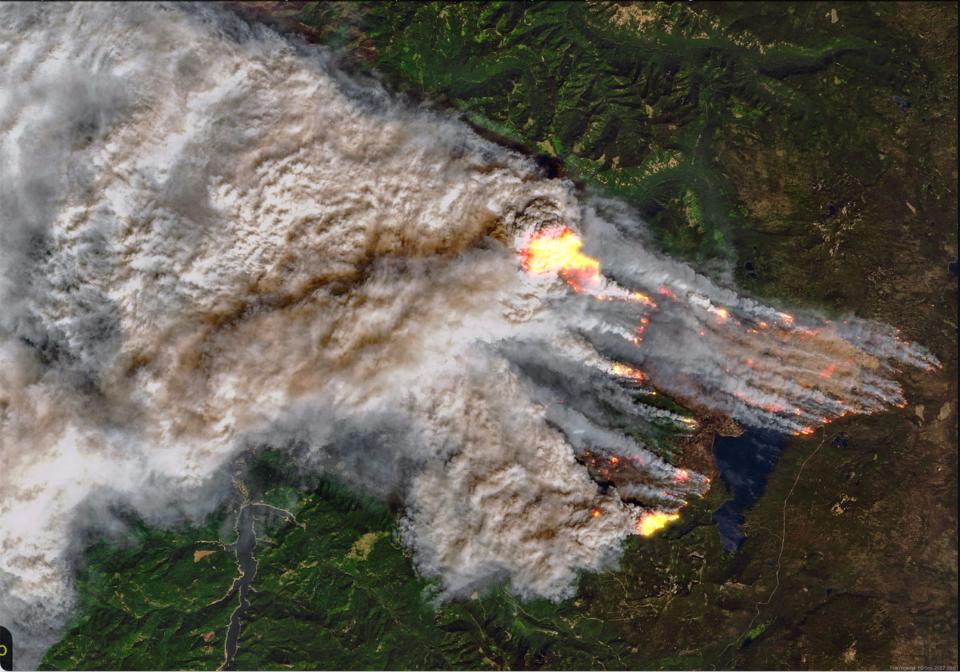Report: Cedar Creek Fire was ‘too dangerous’ for initial firefighting attack
A wildfire that burned 127,283 acres near Waldo Lake, brought evacuations to Oakridge and filled Willamette Valley air with smoke for much of late summer and early fall last year was deemed “too dangerous” to directly attack in the earliest stages of the blaze, according to a report issued Thursday by the U.S. Forest Service.
The Cedar Creek Fire, which became Oregon’s second-largest wildfire of 2022, was turned down for attack by a group of firefighters known as “rappellers” on the first day of the fire, Aug. 1, when it was estimated at two acres. Rappellers drop from aircraft, or rappel, onto a fire area.

“It was burning in heavy timber midway up a 40% slope on a significant cliff with limited options for egress (escape),” the report said. “Shortly before 5 p.m., the rappellers turned down the assignment, reporting the terrain was too hazardous for safe access.”
The fire ignited when lightning struck a tree in the Koch Mountain area of the Waldo Lake Wilderness, roughly 15 miles east of Oakridge.
Helicopters dropped water on the fire both of the first two days but “conditions on the ground made the air resources' attempts to slow the fire spread less effective,” the report said.
On Aug. 2, the fire had grown to five acres and significant spotting and roll out — basically fireballs that roll downhill and ignite fires below — were observed, the report said.
“The crews were unable to safely engage the lower portion of the fire as it grew substantially throughout the shift,” the report said.
By Aug. 4, the fire had grown to roughly 500 acres and established itself as a long-term event.

The Cedar Creek Fire showed modest growth for the rest of August, even allowing officials to keep parts of Waldo Lake open to recreation. Fire officials said the fire was burning at a nice low intensity that was beneficial for forest health, in a way that clears up brush and ground fuels without killing many trees, then-fire spokeswoman Kassidy Kern said at the time.
That changed in early September — particularly Sept. 9 and 10 — when a strong east wind event caused the fire to grow rapidly, bringing level 3 evacuations to the Oakridge area. The fire caused 37 days of poor air quality in Oakridge — and eight in Eugene — while costing $132 million to manage.
This year, many roads and campgrounds within the fire’s scar remain closed. The forest and its trails are technically open but many are burned or difficult to reach.
More: PCT reopens, Waldo Lake area partly reopens as Cedar Creek Fire closure reduced
Why wasn't the fire put out?
A frequent question follows major wildfires, including this one: Why wasn’t the fire put out when it was small?
The answer is almost always safety.

Forest Service officials have repeatedly stressed the importance of firefighter safety in making decisions about when and where to attack fires, and that was true on the Cedar Creek Fire.
“The fire behavior, the terrain, the fuel loading, all of those made them back off a bit,” Kern said in August 2022. “It was really not safe for them to engage. They didn't have a safety route to get out quickly if winds changed or the fire behavior picked up.”
A deadly area for firefighters
Four firefighters have died in action in Oregon since 2020, and two of those fatal accidents took place in the mountains around Oakridge.
Collin Hagan, a hotshot firefighter from Colorado, died Aug. 10 fighting the Big Swamp Fire in the Oakridge area that was sparked by the same lightning storm that ignited the Cedar Creek Fire.
The year before, in August 2021, Frumencio Ruiz Carapia, 56, who was working the Gales Fire, also near Oakridge, died when he was hit by a tree.
"It's a hazardous profession," Alex Robertson, regional fire director for the U.S. Forest Service, said last autumn about the 2022 fire season. "We were fighting fire in some unforgiving landscapes. The sweet spot is looking for fires where we're going to have the best chance of success while not putting people in dangerous places, or in places where if there's an injury, we can't get them out.”
The Forest Service was successful in containing multiple other fires in the same area, from the same lightning storm, including the Bobby Lake, Big Swamp, Windigo and Potter fires.
A troubling trend in Oregon
There are also risks to backing off a fire when it’s small, however.
Cedar Creek was far from the first Oregon wildfire that was deemed too dangerous to directly attack that later exploded into a serious inferno.
The pattern of events at Cedar Creek echoes other major fires in Oregon’s recent history, including the Beachie Creek (2020), Whitewater (2017) and Chetco Bar fires (2017).
In each of those incidents, lighting strikes ignited fires deep in rugged wilderness areas where hotshot or rappel teams decided they were too dangerous to attack. After the fire had established, fire crews shifted to indirect tactics — essentially putting the fires in a box with forest roads and fire lines serving as a containment zone and occasional air drops.
But in each case, the arrival of notorious east winds, which act as a blast-furnace on active fires, caused the fires to spread far beyond the containment zones and explode into megafires over 100,000 acres.

Read the Cedar Creek Fire report
The full story map and report on the cause, spread and actions of firefighters in the Cedar Creek Fire can be found at: tinyurl.com/32kch86k. The report includes video, maps showing the spread of the fire and other multimedia elements.
Zach Urness has been an outdoors reporter in Oregon for 15 years and is host of the Explore Oregon Podcast. Urness is the author of “Best Hikes with Kids: Oregon” and “Hiking Southern Oregon.” He can be reached at zurness@StatesmanJournal.com or 503-399-6801. Find him on Twitter at @ZachsORoutdoors.
This article originally appeared on Salem Statesman Journal: Report: Cedar Creek Fire was ‘too dangerous’ for initial attack

